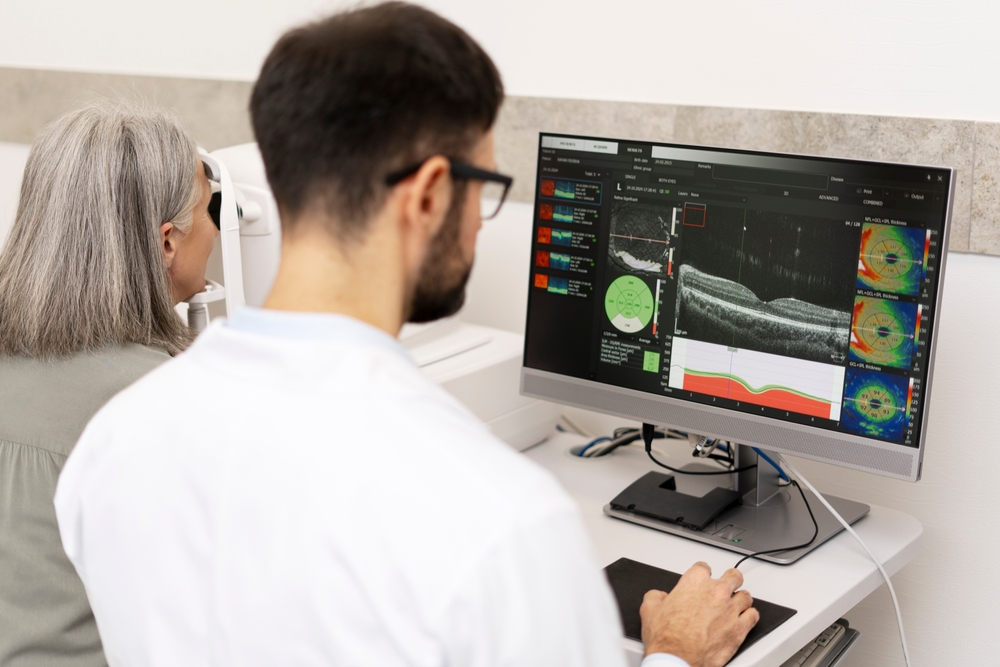How Do Eye Doctors Diagnose Glaucoma?
Glaucoma affects millions of people worldwide, yet up to half of those who have it don’t even know. This silent threat to vision develops gradually, often without warning signs, until significant damage has already occurred.
The key to preserving your sight lies in early detection through comprehensive eye examinations. Keep reading to learn more about how eye doctors diagnose glaucoma and whether it’s time for you to schedule a glaucoma screening with your eye doctor.
Why Early Detection Matters for Glaucoma

Glaucoma is the umbrella term for a group of eye conditions that damage the optic nerve, which transmits visual information from your eye to your brain. In most cases, this damage results from elevated pressure inside the eye, though glaucoma can also develop when eye pressure remains within normal ranges. Without treatment, glaucoma gradually destroys peripheral vision before progressing to complete blindness, making it the second-leading cause of blindness worldwide.
What makes glaucoma particularly dangerous is its subtle progression. Most types produce no symptoms until vision loss becomes noticeable. By that point, the damage is irreversible.
This is why comprehensive diagnostic testing is so important. It allows your eye doctor to detect glaucoma before it steals your sight.
How Do Eye Doctors Test for Glaucoma?
Complete EyeCare West’s glaucoma diagnostic process involves five key examinations that work together to provide your eye doctor with a comprehensive picture of your eye health. Each test provides unique information that helps us accurately identify glaucoma and monitor its progression:
Measuring Your Eye Pressure
The first step in glaucoma diagnosis is tonometry, an eye pressure test that measures intraocular pressure (IOP). Your eye doctor uses a specialized instrument called a tonometer to measure the pressure inside your eye.
Normal eye pressure ranges from 10 to 21 millimeters of mercury (mmHg). However, glaucoma doesn’t follow a one-size-fits-all pattern. Some people develop glaucoma despite having pressure within this normal range, while others can tolerate higher pressures without damage.
Understanding your baseline eye pressure and tracking changes over time helps your eye care team assess your glaucoma risk and guide treatment decisions. This is why eye doctors typically monitor IOP at every comprehensive eye exam.
Examining the Optic Nerve

Ophthalmoscopy allows your optometrist or ophthalmologist to directly examine your optic nerve’s shape and color. After dilating your pupil with eye drops, they use specialized lenses and lighting to view the back of your eye.
They look for specific signs of glaucoma damage, including cupping of the optic nerve and changes in its healthy pink coloration. Complete EyeCare West also utilizes Optical Coherence Tomography (OCT), an advanced imaging technology that measures the thickness of your nerve fiber layer.
OCT works similarly to ultrasound but uses laser light instead of sound waves. This non-invasive scan creates detailed images of your optic nerve structure, allowing eye doctors to detect even subtle changes that might indicate early glaucoma damage.
Mapping Your Visual Field
Perimetry, also known as visual field testing, creates a map of your complete field of vision. This test helps determine whether glaucoma has affected your sight and documents the extent of any vision loss.
During visual field testing, you’ll focus on a central point while lights of varying brightness appear in your peripheral vision. You’ll press a button each time you see a light.
The test automatically retests areas where you may have missed spots, so don’t worry if you feel uncertain about some responses. Your results may vary depending on factors such as fatigue, so your eye doctor may repeat the test to ensure accuracy.
After a glaucoma diagnosis, eye care professionals typically perform visual field tests once or twice yearly to monitor for changes in your vision that would indicate disease progression.
Examining the Drainage Angle
Gonioscopy examines the angle where your iris meets your cornea, which is the area that controls fluid drainage from your eye. The two major categories of glaucoma are open-angle glaucoma and narrow-angle glaucoma, which both involve blockages in the drainage angle of your eye.
For this examination, your eye doctor numbs your eye with drops, then gently places a specialized hand-held lens containing a mirror on your eye for a few moments. This allows them to see the drainage angle’s structure and determine if it’s blocked.
Corneal Thickness Measurement
Pachymetry measures your cornea’s thickness using a probe that rests gently on your eye’s surface. This simple, painless test provides important information because corneal thickness can influence eye pressure readings.
A thicker cornea may cause tonometry readings to appear higher than actual pressure, while a thinner cornea may result in lower readings. Additionally, a thin cornea itself is a risk factor for developing glaucoma. By understanding your corneal thickness, your eye care team can more accurately interpret your eye pressure measurements and develop a treatment plan tailored to your specific needs.
How Often Should I Have Glaucoma Testing? 
Most adults should have comprehensive eye exams, including glaucoma screening, every one to two years. If you’re over 40, have a family history of glaucoma, or have other risk factors, you may need more frequent testing.
Glaucoma may be incurable, but it’s highly manageable when detected early. Complete EyeCare West’s comprehensive diagnostic approach combines multiple testing methods to accurately identify glaucoma and monitor its progression.
Don’t wait until you notice vision changes to schedule an eye exam. By the time glaucoma symptoms appear, permanent damage has already occurred. Regular comprehensive eye exams remain your best defense against vision loss from this silent disease.
Schedule your comprehensive eye exam at Complete EyeCare West in Columbus, OH, today and take an essential step toward protecting your vision for years to come.








